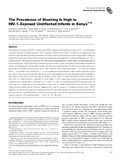The Prevalence of Stunting Is High in HIV-1–Exposed Uninfected Infants in Kenya

Date
2012Author
McGrath, Christine J
Nduati, RW
Richardson, Barbra A
Kristal, Alan R
Mbori-Ngacha, DA
Farquhar, Carey
John-Stewart, Grace C
Type
ArticleLanguage
enMetadata
Show full item recordAbstract
As prevention of mother-to-child HIV-1 transmission (PMTCT) programs decrease the numbers of HIV-1–infected infants, it remains important to improve growth in HIV-1–exposed, uninfected (EU) infants. To determine the growth rate and predictors of growth faltering in breast-fed and formula-fed EU infants, growth analyses [weight-for-age (WAZ), weight-for-length (WLZ), and length-for-age (LAZ) Z-scores] were conducted by using data from a randomized feeding trial in HIV-1–infected women in Kenya. Growth faltering in EU infants was compared based on randomization to breastfeeding (BF) or formula feeding (FF) using Cox proportional hazards regression models. Linear mixed-effects models determined rate and cofactors of length growth. Among 338 EU infants, 164 (49%) were breast-fed and 174 (51%) formula-fed. In both arms, growth declined steadily during follow-up. By 2 y, 29% of children were underweight (WAZ < −2), 18% were wasted (WLZ < −2), and 58% were stunted (LAZ < −2), with no differences by feeding arm. Higher maternal education (y) and taller stature (cm) were associated with a decreased risk of underweight and stunting [underweight: adjusted HR (aHR) = 0.90 (95% CI: 0.83, 0.99), P = 0.03, and aHR = 0.92 (95% CI: 0.87, 0.97), P = 0.002; and stunting: aHR = 0.91 (95% CI: 0.85, 0.97), P = 0.003, and aHR = 0.96 (95% CI: 0.92, 0.99), P = 0.02, respectively]. Diarrhea was associated with an increased risk of wasting [aHR = 2.26 (95% CI: 1.11, 4.62), P = 0.03]. In multivariate analyses, FF was associated with slower declines in length velocity [0.24 LAZ/y (95% CI: 0.06, 0.43), P = 0.009]. Despite being uninfected, HIV-1–exposed infants showed frequent growth faltering, suggesting the need for vigilance in recognizing stunting within PMTCT programs. The slower rate of decline in length growth with FF may reflect benefits of micronutrients. Because BF is the best option for HIV-1–infected mothers in resource-limited settings, nutritional interventions should be examined for their impact on growth in EU breast-fed infants.
URI
http://erepository.uonbi.ac.ke:8080/xmlui/handle/123456789/21638http://www.ncbi.nlm.nih.gov/pubmed/22378334
Citation
J Nutr. 2012 April; 142(4): 757–763.Description
Full text
Collections
- Faculty of Health Sciences (FHS) [10378]
